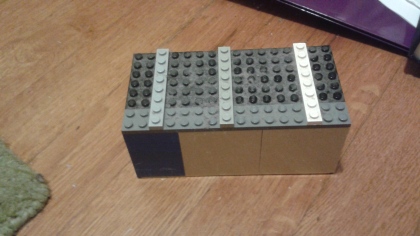Filed under: Uncategorized
On October 25, I found a small box made of Legos under a radiator.

This box had been there for over four years. According to a slip of paper stored inside, I made and closed the box on April 7, 2011. Some time after that, I moved it from my radiator to my parents’, where it stayed until this October.

The box and its contents.
Inside the box were these items:
Clockwise from upper left: The labels from a bottle of San Pellegrino (which may still be on my shelf); paper with the date of sealing; some thread; a balsa card painted gold; part of an orange zip tie; some of my hair; Vontromp the Lego guy.
As for why I did this, it’s a little complicated. I have done this sort of thing at least twice before, and when I made this box, I distinctly remember that I wanted to forget about it before I found it again. That only partially worked; I remembered the box’s exsistence, and three of the things inside (Vontromp, the gold card, and the date slip), but I forgot the exact date of sealing, all the other contents, and its eventual location.
Filed under: Hephaestus Makes
So there’s this webcomic called Homestuck. It’s a massive, ~8,000-page, rambling story about teens, aliens, video games, and the fate of existence itself. But enough about that; if I go down that train of thought, I’ll never get back.
One of the countless facets of the story is fantastical, often ridiculous, and occasionally legendary weaponry. One of those weapons is the Warhammer of Zillyhoo.

This is what it looks like.
So one day in October, I decided that I wanted to make this thing.
Construction
Most of the hammer is made of this stuff called floral foam. It’s a stiff plastic foam material, which can be easily carved, sawed and glued. Everything except for the blue box in the front, the handle and the star are made from this stuff, covered completely by a synthetic spackling paste.
The horn-shaped parts were made by cutting foam cones into segments, then gluing them back together at an angle and chipping and filing the edges into a curve. I used dowel rods to reinforce the sections.
I made the central block by cutting a large cube down to size. Then, I cut a channel into it by first making two vertical cuts, then chopping out the excess with a spade bit. I used the same spade bit to drill holes for the reinforcement.
To give the hammer some internal strength, I used PVC pipe running through the block into the head and tail, with the handle made from the same and emerging from the bottom of the block.
Then, it was time for spackling.
The spackling behaved rather like a very sticky, smelly frosting when wet, and is slightly flexible when dry. This gives the spackling-covered surfaces some resiliency.
For the big block at the front end, I used 1/8″ plywood to make a box. This is so thin that I had to have blocks of wood inside the box in order to screw it together. To attach it to the rest of the hammer, I used what is called a pipe floor flange, which can screw on to a pipe fitting. A length of pipe emerging from the block went into the fitting.
I actually screwed up and made the pipe section too short, so that we had to buy a couple more fittings and stick them together to get sufficient length. My dad actually did a lot of that himself, as I was busy at the time.
Finishing
Next step: Painting. I used Craft Smart acrylic paints in red, orange, yellow, blue, purple and white (for lightening colours). The green paint was Galleria artists’ paint, which required twice as many coats to get right.
After all the painting was finished, I wrapped the PVC handle in coloured duct tape.
The final step was simply coating the entire painted surface in glossy Mod Podge to give it a nice shine.

There she is. Forged in fire by the smiths of Pipplemop, commissioned by the sage Lord of the Wozzinjay Fiefdom in the Realm of the Snargly Fruzmigbubbins… Just kidding; I made it myself.
In total, the hammer weighs 2.210 kilograms, or about 4 pounds ten ounces, or 0.34 stone. In length it is 63 cm head to tail and 80 cm top to handle tip. The head is approximately 20 cm wide. The materials cost around sixty dollars, and it probably took around twenty hours of work to make.
Let me know in the comments what you think of this project, and if you have any technical questions I will be happy to answer them.
Filed under: Words of the Months
Etymology: circa 16th cent,; direct from New Latin contrafactum, neuter past participle of contrafacere, meaning to counterfeit, created from contra- (against) prefix and facere, to do. According to Merriam-Webster, contrafacere is a translation of Middle French contrefaire.
Definition: A song created by combining new words with a previously used tune.
Wow, this is another weird etymology, isn’t it? It’s not every day you find a word borrowed from a Latin translation of French.
Traditionally, the term was mostly applied to religious or liturgical music with secular words added. However, the definition has broadened to the point where we can apply it to songs where both the words and music are of a secular nature.
Some contrafacta you may know include:
The Star-Spangled Banner (Music To Anacreon in Heav’n, 1700s; words The Defence of Fort M’Henry, 1814)
My Country ‘Tis of Thee (Music God Save the Queen [King], prior to 1744; words 1831) (The tune may be even older, but it’s very hard to tell).
The Russian National Anthem (Music State Anthem of the USSR, prior to 1944; words 2000) (The first ever Russian anthem was a contrafactum on God Save the Queen).
`Two famous Christmas carol contrafacta are Hark, the Herald Angels Sing (Music Festgesang Cantata, 1840, words even older, dating to 1754 in their current form), and perhaps the most famous contrafactum in English poetry, What Child is This to the tune of Greensleeves.
Note that contrafactum and contrafact are not identical; a contrafact is a jazz term meaning a melody written on a borrowed harmonic structure (no words necessary).
Please let me know if there are any words you would like featured in the comments below.










